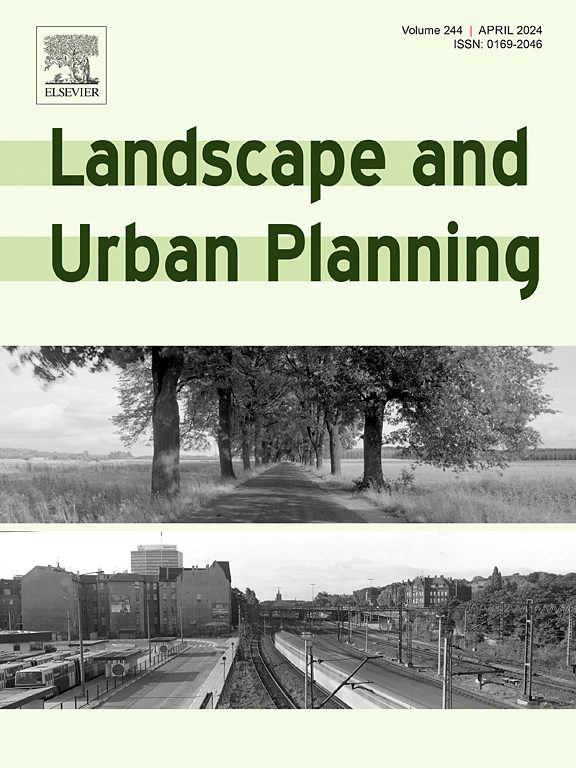城市绿地与设计要素的比较环境生命周期评价——以维也纳为例
IF 7.9
1区 环境科学与生态学
Q1 ECOLOGY
引用次数: 0
摘要
城市绿地因其多种生态系统服务而变得越来越重要。到目前为止,环境影响评估的重点主要集中在温室气体排放上。因此,本研究旨在采用生命周期评估方法,评估维也纳常见绿地在整个生命周期中对气候变化、细颗粒物形成、海洋富营养化和陆地酸化等类别的影响。以 30 年内 1 平方米覆盖面积的功能单位(FU)为基础,对公用草坪(UL)、草甸草坪(ML)和多年生花坛进行了比较。此外,还在假定的公园组合中评估了 UL 和 ML 的相互组合以及与两种不同路径方案的组合。结果表明,与广泛维护的绿地(ML、多年生花坛)相比,密集维护的 UL 绿地对环境的影响更大;例如,在气候变化影响类别中,ML 和多年生花坛对环境的影响分别为 2.90 和 10.68 千克二氧化碳当量/单位,而 UL 绿地对环境的影响为 54.59 千克二氧化碳当量/单位。总体而言,在每个评估影响类别中,维护阶段都是一个热点。增加 UL 的面积可减少对环境的影响;例如,面积增加 2.5 倍,全球升温潜能值就会降低 50%以上。将 UL 和 ML 结合在一起时,由于减少了施肥和除草,海洋富营养化的可能性会大大降低。绿地和路径的结合不会导致环境影响的大幅增加或显著减少。本文章由计算机程序翻译,如有差异,请以英文原文为准。

Comparative environmental life cycle assessment of urban green spaces and design elements – A case study in Vienna
Urban green spaces are becoming increasingly important due to their multitude of ecosystem services. Until now, the focus of environmental impact assessment has been mainly on greenhouse gas emissions. Hence, this study aims to assess common green spaces in Vienna with the method of life cycle assessment for the impact categories climate change, fine particulate matter formation, marine eutrophication and terrestrial acidification over the whole life cycle. A utility lawn (UL), a meadow lawn (ML) and a perennial bed are compared with each other based on the functional unit (FU) of 1 m2 covered area over 30 years. Further, combinations of UL and ML with each other and with two different pathway options are assessed in hypothetical park compositions. Results show that the UL as intensively maintained green space has higher environmental impacts compared to extensively maintained ones (ML, perennial bed); e.g., in the impact category climate change ML and perennial bed have an impact of 2.90 and 10.68 kg CO2 eq./FU, respectively compared to UL with 54.59 kg CO2 eq./FU. Overall, the maintenance phase is a hotspot in every assessed impact category. When increasing the size of UL this leads to a reduction of environmental impacts; e.g., a 2.5 times bigger area reduces the GWP by over 50 %. When combining UL and ML, the marine eutrophication potential can be reduced significantly due to less fertilizing and mowing. A combination of green space and pathways does not result in a large increase or a significant reduction in environmental impacts.
求助全文
通过发布文献求助,成功后即可免费获取论文全文。
去求助
来源期刊

Landscape and Urban Planning
环境科学-生态学
CiteScore
15.20
自引率
6.60%
发文量
232
审稿时长
6 months
期刊介绍:
Landscape and Urban Planning is an international journal that aims to enhance our understanding of landscapes and promote sustainable solutions for landscape change. The journal focuses on landscapes as complex social-ecological systems that encompass various spatial and temporal dimensions. These landscapes possess aesthetic, natural, and cultural qualities that are valued by individuals in different ways, leading to actions that alter the landscape. With increasing urbanization and the need for ecological and cultural sensitivity at various scales, a multidisciplinary approach is necessary to comprehend and align social and ecological values for landscape sustainability. The journal believes that combining landscape science with planning and design can yield positive outcomes for both people and nature.
 求助内容:
求助内容: 应助结果提醒方式:
应助结果提醒方式:


